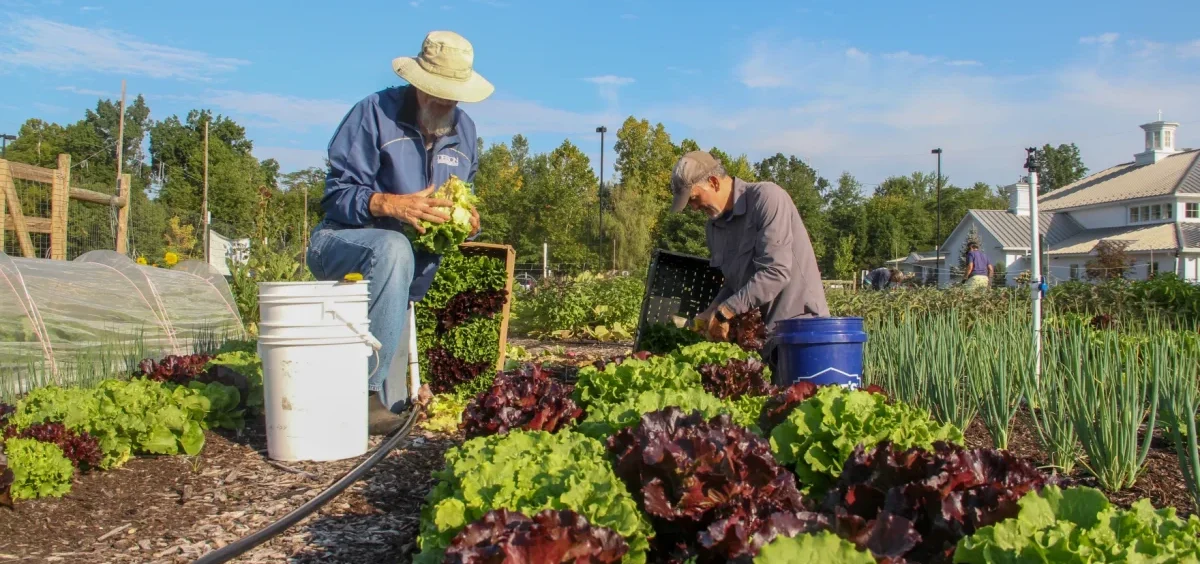News

Community gardens hope to sow solutions to growing hunger
By: Allie Vugrincic | WOSU
Posted on:
NEW ALBANY (WOSU) — On a warm Wednesday morning, volunteers met outside All Saints Episcopal Church in the affluent Columbus suburb of New Albany.
Shawn Duffy wheeled out a whiteboard and gave the volunteers their harvest orders: tomatoes, collard greens, half a row of lettuce, peppers, squash and zucchini. Pulling carts and carrying crates, they headed toward either of two large, fenced-in gardens encircled by flowers.
The vegetables they gathered would head to Healthy New Albany Food Pantry for that afternoon’s food distribution and could end up on the plates of hungry families as soon as that evening.
Community gardeners have long been sharing their harvests with friends and neighbors. Now, some community gardens are cultivating a solution to hunger, which is on the rise in suburbs like New Albany.
“Our core value is that all people deserve the best that the earth has to offer, regardless of socioeconomic status,” said Reverend Catherine Duffy.
Duffy is the associate priest at St. Patrick’s Episcopal Church in nearby Dublin, but she and her husband, Shawn, started the garden at All Saints Episcopal when they were members there in 2020. They call it The Garden for All.
It began with three 25-foot rows that produced around 750 pounds of food – all for local food pantries. The Duffys wanted to provide nutritious foods that would contribute to overall better health – and they wanted to do it with organic, Earth-friendly gardening.
“Health equity depends on good nutrition, and we would very much like to be part of that solution,” Catherine Duffy said.

In its fifth growing season, the now sprawling gardens and nearly 250 volunteers are set to grow around 10,000 pounds of produce and plenty of bouquets of fresh-cut flowers.
Catherine Duffy said it’s still not enough.
“The feedback that we get from our pantries is that the need far outpaces what they get from us or what they get from anywhere,” Catherine Duffy said.
An invisible problem
Recently, the Garden for All has started making weekly deliveries to the Healthy New Albany food pantry. The pantry has served 20% more families this year than last, according to director Jennifer Wilcoxon. Just this summer, the pantry served more than 50 new families, mostly with school-aged children.
It’s not what you’d expect in the idyllic suburb known for its white horse fences and rolling country landscapes.
“Food insecurity is definitely in New Albany,” Wilcoxon said. “It’s moving to the suburbs.”
She said families are moving to New Albany for the schools, but they struggle with the high cost of living. Often, multi-generational families live together in small apartments.
Catherine Duffy believes that creates an often-invisible problem. She hopes The Garden for All helps shines some light on it.
“We are helping people know that hunger exists, and we are geographically situated in a place where you can’t see it,” Duffy said.
But hunger is everywhere – and everywhere, people are trying to grow solutions.
Urban community gardens begin to sprout
In August, the Mid-Ohio Food Collective, which serves 20 Ohio counties, officially opened its 7-acre Mid-Ohio Farm on the Hilltop. The technology-rich urban farm on Columbus’s west side is already helping supply Mid-Ohio’s food bank and fresh markets.
The farm is situated on the grounds of what was Ohio’s first state psychiatric hospital. It was a brownfield — land that had been developed and carries pollution from industrial use. For that reason, most of the produce at the farm is not planted in the ground – it’s floating on hydroponic beds or stacked in towers of buckets. The techniques allow to for high yields and nutrient-rich plants.

Planting at the farm started in March. Since then, just one greenhouse has produced more than 1,600 pounds of food including, around 1,000 pounds of cucumbers, around 270 pounds of tomatoes and 400 pounds of lettuce.
Mike Hochron with Mid-Ohio Food Collective’s communications said when means get tight, expensive fruits and vegetables are the first thing that families take out of their grocery carts.
“And so, by growing all of this food and getting it directly into that food supply, we are ensuring that these families have access to some of the most nutritionally dense, nourishing foods they could possibly get,” Hochron said.
Hunger is on the rise
In 2023, Mid-Ohio saw a 30% increase in visits overall, and 2024 has continued to trend slightly higher, Hochron said.
“Food insecurity has increased everywhere, including places that you might not expect,” he said.
Around Franklin County, community gardens – plots run by volunteers or neighbors – are doing their part, too.
Last year, 27 gardens in Franklin County, including The Garden for All, together donated around 38,000 pounds of food to 21 neighborhood food pantries, according to Mike Hogan, an educator with Ohio State University Extension.
Hogan said since the pandemic, people – especially gardeners – are more aware of food insecurity.
“I think community gardeners have always shared produce with anybody in need, anybody that wanted it,” Hogan said. “But [addressing hunger] is really an objective of a lot of community gardens right now.”
Back in New Albany, The Garden for All plans to use a new greenhouse to grow during the winter months, when suburban pantries find it especially hard to get fresh food.

“We may not be able to solve hunger for the world or for all of central Ohio. But, at the same time, we’re doing we’re doing something meaningful, and we’re starting to do something meaningful on a larger scale,” Catherine Duffy said.
So, the Duffys, The Garden for All volunteers and gardeners all over Ohio will continue to work to put fresh foods on the plates of those who need it most.

